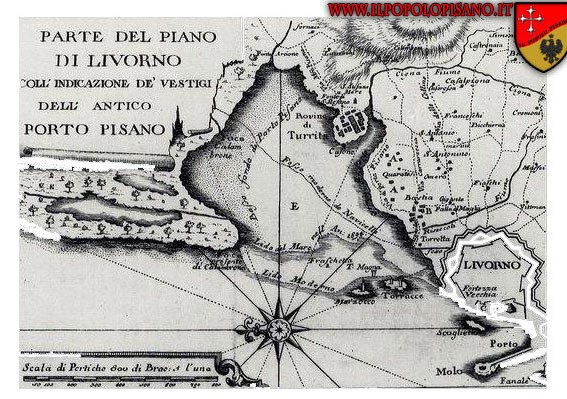Location: 43.5733N 10.3343E
The Roman poet Rutilius Namatianus, who travelled in the 5th c. AD by boat from Rome to Gaul, visited various ports, including Portus Pisanus:
“From there we make for Triturrita: that is the name of a residence, a peninsula lying in the wash of baffled waves. For it juts out into the sea on stones which man’s hand has put together, and he who built the house had first to make sure building ground.
I was astonished at the haven close by, ‘Pisarum Emporio‘, which by report is thronged with sea-borne wealth. The place has a marvellous appearance. Its shores are buffeted by the open sea and lie exposed to all the winds: here there are not sheltering piers to protect any inner harbour-basin capable of defying the threats of Aeolus. But, fringing its own deep-water domain, the tall sea-weed is like to do no damage to a ship that strikes it without shock; and yet in giving way, it entangles the furious waves and lets no huge roller surge in from the deep. […]
So then I moor my ships in the safe anchorage, and myself drive to Pisa by the road the wayfarer goes afoot. […]
I scan the ancient city of Alphean origin, which the Arno and the Ausur gird with their twin waters; at their junction the rivers form the cone of a pyramid: the opening front offers access on a narrow tongue of land; but it’s the Arno that retains its own name in the united stream, and in truth the Arno alone arrives at the sea.”
(de Reditu suo, Book 1, verse 527, Transl. Lacus Curtius).“

(Targioni Tozzetti, 1768-1779)
This interesting description shows several features:
- Coming with a ship from the south (from Rome) they first pass a man-made peninsula with a villa maritima called Triturrita. An 18th c. chart shows that this villa (Turrita) is located at the modern ‘Cimitero comunale dei Lupi’.
- The port where he moors his ships, called Pisa’s emporion, is not protected by breakwaters, but by a field of sea-weed that is known to reduce wave action without damaging the ship’s hull when passing through it. This may be a lagoonal area near the estuary of river Cigna. Recent archaeological discoveries were made at San Stefano ai Lupi (Allinne et al. 2014).
- A clear distinction is made between ‘Pisarum Emporio’ and the city of ‘Pisa’ that is to be reached on foot.
- Pisa was built at the confluence of the Arno river and the Auser river now called Serchio and flowing further north. By the way, Strabo (Geog. 5, 2, 5) warns that sailing the Arno river from the sea to the city, located two nautical miles upstream, is very difficult for sea ships.
Further (fascinating) reading on: https://www.romanports.org